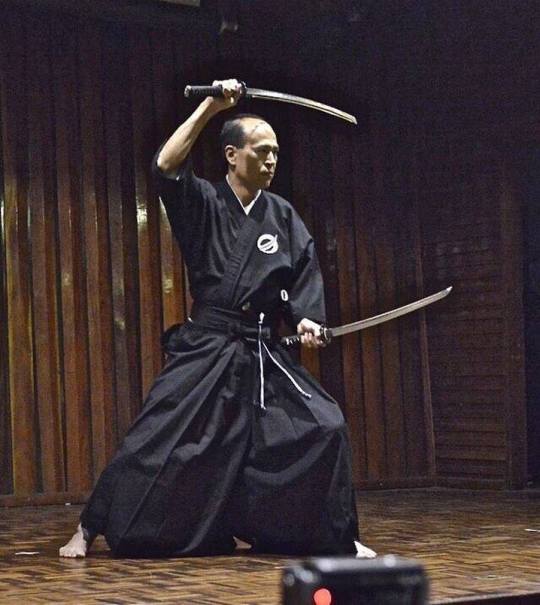#Nito-ryu
Text
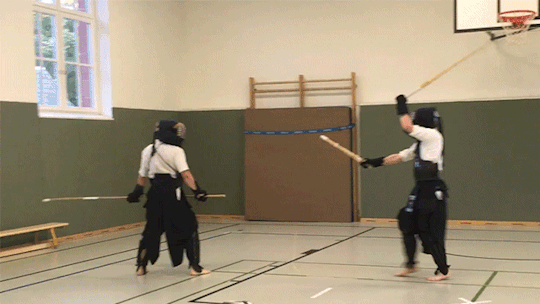
Wakigamae to men-uchi
50 notes
·
View notes
Text
So I've decided to make a blog...
I'm not positioning myself as an authority on kendo or anything. I guess I just want somewhere to put my thoughts, and who knows, maybe I can become a z-list internet celebrity or something one day! 😂
1 note
·
View note
Text

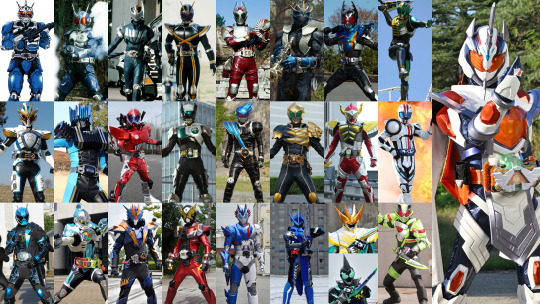
All Secondary Kamen Riders:
Kaoru Ichijo ("Honorable Mention"/Kamen Rider G3)
Makoto Hikawa (Kamen Rider G3)
Ren Akiyama (Kamen Rider Knight)
Masato Kusaka (Kamen Rider Kaixa)
Sakuya Tachibana (Kamen Rider Garren)
Iori Izumi (Kamen Rider Ibuki)
Arata Kagami (Kamen Rider Gatack)
Yuto Sakurai (Kamen Rider Zeronos)
Keisuke Nago (Kamen Rider Ixa)
Daiki Kaito (Kamen Rider Diend)
Ryu Terui (Kamen Rider Accel)
Akira Date & Shintaro Goto (Kamen Rider Birth)
Ryusei Sakuta (Kamen Rider Meteor)
Kosuke Nito (Kamen Rider Beast)
Kaito Kumon (Kamen Rider Baron)
Go Shijima (Kamen Rider Mach)
Makoto "Rion" Fukami (Kamen Rider Specter)
Hiiro Kagami (Kamen Rider Brave)
Ryuga Banjo (Kamen Rider Cross-Z)
Geiz Myokoin (Kamen Rider Geiz)
Isamu Fuwa (Kamen Rider Vulcan)
Rintaro Shindo (Kamen Rider Blades)
Daiji Igarashi (Kamen Rider Live) & Kagero (Kamen Rider Evil)
Keiwa Sakurai (Kamen Rider Tycoon)
Rinne Kudo (Kamen Rider Majade)
#kamen rider#kamen rider g3#kamen rider knight#kamen rider wing knight#kamen rider kaixa#kamen rider garren#kamen rider ibuki#kamen rider gatack#kamen rider zeronos#kamen rider ixa#kamen rider diend#kamen rider accel#kamen rider birth#kamen rider meteor#kamen rider beast#kamen rider baron#kamen rider mach#kamen rider specter#kamen rider brave#kamen rider cross z#kamen rider geiz#kamen rider vulcan#kamen rider blades#kamen rider live#kamen rider evil#kamen rider tycoon#kamen rider majade#masked rider
129 notes
·
View notes
Note
If you had to create a roster for the Einherjar (without using those already on the list) who would you pick from history?
For a more fun one let’s play which Isekai characters would you pick to be an Einherjar?
This was quite fun to do!
1. Alexander the Great, educated, a strong warrior before he was king, responsible for sacking the Persian Empire, but even when the Persian King fled, he left the coward king’s family unharmed, showing that he was also compassionate. He died young and his heirs were assassinated shortly after and the empire promptly fell apart without his guidance.
2. Genghis Khan, one of history’s most infamous leaders, conquered the Mongol Empire plus most of Asia and Europe during his reign. A strong warrior and brilliant tactician who ruled his massive army, and had so many children with various women that his descendants could form their own army today. I love the mystery that nobody knows how he died or where his body is.
3. William Wallace, famous for leading Scotland to its freedom from the English, he may have not been the one to actually do it, but his actions as a warrior and a leader set in motion to the Scots rising up against King Edwards I following his death. His death was tragic, being betrayed and then executed in horrible ways and having his severed body parts displayed around England.
4. Miyamoto Musashi, a ronin samurai who killed his first person at age 13. He traveled alone with no affiliations to train his skills with a sword, which resulted in nito ichi-ryu, better known as kensai, battling with two swords. His most well-known fight was against Sasaki Kojiro, which he won, but then retired to train others with swords and retired with an undefeated record of 61 duels.
5. Spartacus, warrior turned slave turned gladiator turned rebellion leader, courageous but compassionate, a ruthless warrior who offered his enemies both mercy and respect, and led an army of rebels against their oppressors, the Roman Empire.
6. Achilles, who led the Greek army against Troy, killing Hector at the gates, a proud and strong warrior and leader, but he needs to make sure to wear iron boots that are impenetrable as everyone knows his weak spot.
7. Ching Shih, a female pirate who commanded 300 ships and was able to go toe-to-toe with the Chinese Imperial Navy. If you disobeyed you were immediately executed, but the same went for if her men raped captives, she had a no tolerance policy. She ended up getting to retire with all her wealth after the Imperial Government offered both her and her crew amnesty after they were defeated under the agreement that they would stop.
8. ‘Mad Jack’ Churchill, a British solider in WWII that charged into combat with weapons that were not common for the time, such as a sword and long bow. He was disappointed the war ended with the bombings of Hiroshima and Nagasaki, as he wanted to keep fighting. He once stormed a German held down in Italy with just one other man and captured a mortar position and 42 men with just his sword, long bow and his bagpipes.
9. Amanirenas, one eyed ancient queen of Kush, now modern day Sudan, who fought back against the Roman Empire, after the death of Cleopatra, when they decided to try to expand past Egypt, so viciously that Rome and Augustus were quick declare peace between the two empires after they couldn’t win due to the unbearable heat and the pissed off queen. A fierce tactician who used supposedly used war elephants, fed captors to her pet lion, and defaced Augustus’ statues and kept the head of one statue under the feet of the throne of Kush.
10. Lyudmila Pavlichenko, deadliest female sniper in the world; sniper for the Soviet Union in the Red Army during WWII; nicknamed Lady Death and claimed, during her time as a sniper, to have killed 309 soldiers. Became an advocate for peace and toured the world.
11. Jean-Eugene Robert-Houdin a French watchmaker, illusionist, magician and regarded as the father of the modern style of conjuring, having brought magic from something only seen at circuses or similar places like that for the poor, to something of grand entertainment for the wealthy.
12. Richard I of England, a bad king but a brilliant warrior, having spent most of his time in the Crusades, rather than running his own kingdom, or fighting against France
13. Ragnar Lothbrok, Swedish and Danish king, legendary Viking warrior leader who raid both the British Isles and the Holy Roman Empire in the 9th century
As for Isekai~
1. Ainz Ooal Gown- Overlord
2. Rimuru Tempest- That Time I got Reincarnated as a Slime
3. Canya- In the Land of Leadale
4. Azusa Aizawa- I’ve Been Killing Slimes for 300 Years and Maxed out my Level
5. Yuna- Kuma-Kuma-Kuma Bear
6. Albedo- Overlord
7. Diablo- That Time I got Reincarnated as a Slime
8. Shiraori- So I’m a Spider, So What?
9. Seiya Ryuguin- Cautious Hero: The Hero is Overpowered but Overly Cautious
10. Mamako Oosuki- Do You Love your Mom and Her Two-Hit Multi-Target Attacks?
11. Diablo- How Not to Summon a Demon Lord
12. Hajime Nagumo- Arifureta: From Commonplace to World’s Strongest
13. Teacher and Fran- Reincarnated as a Sword
19 notes
·
View notes
Text
A Premature Burial Episode 4
A Premature Burial
Episode 4
Season: Winter
Characters: Kuro, Nazuna, Mika, Shu
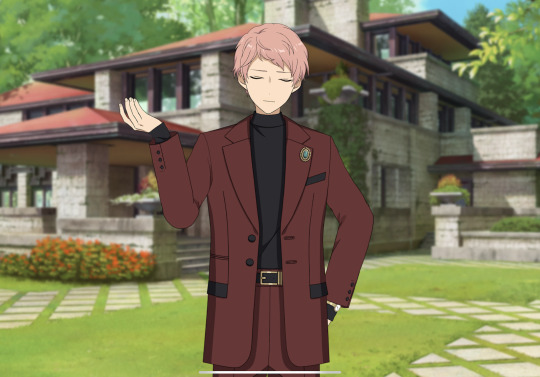
Shu: However, if you use your brain, you should be able to speculate for yourself.
This is simply a villa, and the Itsuki family's main residence is in Kansai. That’s why I go back to the “countryside” often during new year’s and such.
Because of the trouble I had in the surrounding area, I met you.
Mika: Nnah, I always wondered what Oshisan was doin’ in my hometown… Huh, but when ya ran away from home with Ryu-kun-san ya didn’t say anythin’?
Shu: I suppose it was around that destination. At the time, my world was extremely narrow, I knew practically nothing of the region.
Well, after all, I coludn’t get anywhere with my child’s feet, and my little childhood adventure came to an end with no accomplishments—
Mika: That’s where I got t’ meet ya~? Besides, Oshisan can go wherever now, right?
Shu: I wonder. Even if I’m able to discuss art in a foreign language with westerners in Paris, my flesh and blood are still held captive by this suffocating building.
That’s the feeling I have. Humans can simply never be free from their bonds.
Things will always come along to firmly restrict us. Like a marionette with tangled strings.
Mika: Oshisan…
Shu: Ah, what a strange thing to say. I don’t think we should be standing around talking by the eaves, shall we go in?
While we’re at it, answer me this first, the reason I brought you here is because I don’t want to meet with my family alone. Do I need any other reason?
Mika: But, yer family ain’t that scary.
Shu: They aren’t particularly scary, but we don’t have a good relationship. The hierarchy that has been instinctively ingrained into me since childhood is certainly not something that can be ignored.
On that point, if you’re here my family more or less have to keep up their appearance, thus they will go easy on us and I’ll be spared. They too have somewhat taken a liking to you.
Mika: Even though the first time I came here I completely ignored ‘em… I guess I was just real confused and surprised that Oshisan took me in so suddenly.
But I feel like it took some time fer me to open up. If we were gonna live together under one roof, I should express my feelin’s normally.
Aha. first the orphanage, then Oshisan’s house, now Starmony Hall… If I really think about it, I’ve always lived with other people.
Shu: If you’re not happy with that then find a family that you truly wish to live with from now on.
You have hands and feet for that. You have a free soul that is bound by no one. Neither god nor person can stop you from doing that.

Nazuna: Hell~o, Kagehira?
Hmm. You’ve arrived at Itsuki’s house and dropped off your luggage so you’re taking a little break?
So you thought it’d get busy in the morning, and had an early lunch so you could call at noon.
Since Itsuki hurriedly booked a flight and arrived home late, you waited to join him…
Yeah. He didn’t plan on coming home as normal, so he arrived a little later than you.
Hm? It’s lunchtime for me, so I’m just eating lunch as normal?
Yeah… Kuro-chin thinks he can persuade me, he’s using the excuse that he “made too much” to serve me his home cooking…
Kuro: I’m not giving up, Nito.
Nazuna: Hm~… I’ll introduce you to Tomo-chin, I don’t think he’ll resist since he’s always made to wear girls' clothes.
Kuro: I think Nito is a better fit.
Nazuna: I’d rather hear you say that in a completely different situation too… Well, if I’m substituting for your little sister I guess it’s a little different to crossing.
No, whether I like it or not, isn’t it just regular old crossdressing? I don’t get anything out of it?
Kuro: It’s okay. Have some self confidence, Nito, you’re definitely cuter than any other girls.
Nazuna: I’m not happy… You’re so stubborn. That’s exactly what I’d expect from Itsuki’s childhood friend— You’re really similar.
Whatever. Anyway, Kagehira, not to be overbearing, but if anything happens get in touch right away.
Ra*bits have gotten into a strange situation where we’re slowly getting less work, so I have free time. Yeah, I’m not trying to interfere just for fun.
I know I’m not powerless… Maybe I just want to prove that I am able to help someone.
Kuro: You don’t need to prove it. At least right now, you’re helping me.
Nazuna: Oh~ Geez~ What a pain~ You were never the type to whine like this, Kuro-chin? Are you feeling alright?
Kuro: I’ve got a lot of stuff going on. I want to grow out of the dependable, understanding big brother type that doesn’t cause trouble for anyone.
No. I’m in the middle of searching for who I am and what I want to do.
Nazuna: Is that trying to ask your closest male friend to wear elementary school girl’s clothes…? If that’s your true nature you should hide it and not show it to anyone, it’s weird.
Kuro: That’s so mean, I asked you because you’re my closest friend.
Nazuna: Hmph. Oh well, it’s rude to be on my phone while I’m eating, so I’ll hang up. I don’t really understand— but do what you can.
It must be tough looking after Itsuki. But that’s what you want to do… Kagehira♪

#raison d'etre#ensemble stars#enstars#shu itsuki#mika kagehira#kuro kiryu#nazuna nito#english translation
4 notes
·
View notes
Text
Raison d'etre
Episode 1
-Beginning Story 2-
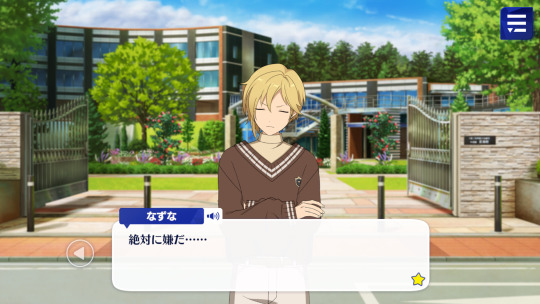
<Next day seisoukan, near the entrance to the residential area>
Nazuna:
Absolutely disgusting…..
Kuro:
Hey there, can you please nod “yes” sensei
-kuro bows his head-
Aren't you friends with itsuki?
Nazuna:
Yeah, but I also want to do whatever kuro-chan asks.
But I hate what I hate.
Kuro:
What is it? You’re not so naive that you’d be embarrassed to be dressed in any strange costume now, aren't you, Nito?
Nazuna:
That's true, But…….
I'm about to turn 20 and I'm a good adult, but sometimes I look at myself in shorts, and think, “what am i doing”? Worrying about being cute.
Ra*bits is that kind of idol group, so i guess it can't be helped.
Kuro:
Oh, if that's the case…~
Nazuna:
And this is a different story! Why is it so sad that I have to wear female clothes made by my friend, Kuro.??
No! It feels nasty!
Kuro:
It is not nasty! Don't say such bad things, it's disrespectful
Why are you so reluctant? I'm just asking you to try on the outfit I made for my sister. Aren't i!
Nazuna:
Are you saying that you don't have the nerve to ask a man of your age to do that~!?
Kuro-chin's younger sister, if i'm not mistaken, she's still in elementary school, isn't she?
Kuro:
It's okay! Nito can do it!!
My little sister is similar to me in growth, and is getting taller and taller. Nito can wear it!
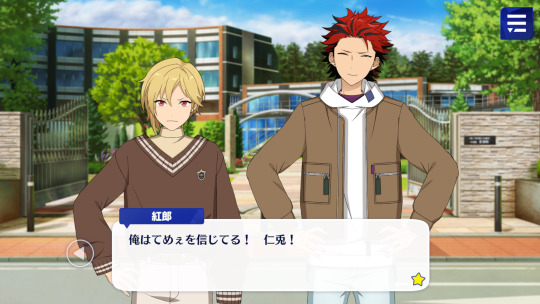
I believe in you! Nito!
Nazuna:
I wanted to hear those words in a different context…
Yes, yes, this story is over! It's unpleasant, Go back to your room!
Because of my friendship with Kuro-chan, I'll ignore this incident, so you can take a walk and cool off already!
Kuro:
Don't say that… I'm begging you, Nito~......
My younger sister has recently become more attractive and wants to be fashionable, but the clothes and accessories she wants are all ridiculously expensive.
I can’t afford it in our financial situation, so i thought i'd sew it myself, it's cheaper that way.
But with clothes, you cant know if they're good or bad unless you actually put your arm through the sleeve, So, what? Nito understands, right?
I'm begging you……… I don't deserve this. Nito……
This is not something i usually say, but ES idols are always pretty good-looking, Nito is a valuable human resource
The only person who seems to be able to wear girls' clothes normally is Nito, even if it's out of the whole world.
Nazuna:
Go buy a mannequin.
Kuro:
Wow, it's been a long time since ive seen that Glass ball, your eyes are cold…
Nazuna:
Most of all,i didn't want to go back to the days when i was acting like a doll in “Valkyrie”, in such a stupid scene
Mika:
……….!
Kuro:
Huh? Look ahead and talk, doesn't that hurt?
Mika:
………..
Kuro:
Hey…………. Did you bump into each other and not say hello? Did something happen, kagehira?
Mika:
Oh, how unbearable, Mr. Ryu-kun…!?
Kuro:
What's Wrong–..... Any trouble?
Mika:
Hmm? No, I have nothing to do with Ryu-kun….
Ah, but “Ryu-kun” is “Ryu-kun”! How are you?
Kuro:
Huh? You call me by the nickname I used when I was a kid, but frankly, it's about the same now, isn't it?
Mika:
“Ryu-kun” is Oshi-san's childhood friend, isn't he?
Kuro:
I can't tell what you are talking about, but what about itsuki?
-Story 2 End-
5 notes
·
View notes
Text
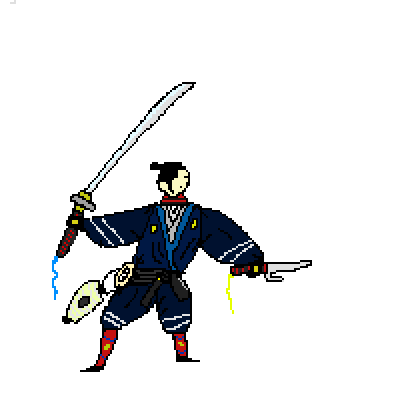
Pixel art of a skilled and accomplished Ichidoshin police officer, trained and distiguished for his fencing skill.
He is fiercely loyal to the Machi-Bugyo Police Magistrate, and by extension the Shogun.
Skilled in the Nito-Ichi-Ryu style of fighting, as will as specializations in Kodachi-Jutsu/Tantojutsu, using his Katana longsword as more of a bladed baton like Kendo, and mainly focusing on pointwork, with bats and slashes with his longsword when one's guard is open.
In the ranks of the police, he is in the 2nd Position, First Rank, the Three Positions being Higher Samurai, Lower Samurai (including the Doshin), and Non-Samurai, with the Rank system being kanji characters attributed to a Doshin, denoting accomplishment and seniority.
It is customary for ranks being inscribed on the belt of an officer, with that practice spreading to Shogun-Alligned Dojo.
He looks for oppuritunities to fight people who look like good swordfights to death, using false charges as a pretense.
#japan#culture#asia#history#samurai#war#creativity#japanese#art#shinto#doshin#edo period#fencing#lore#oc#oc art#oc artwork#oc lore#enemy design#original character#character design#world design#sword fighting#sword#swords#katana#tanto#pixel art
2 notes
·
View notes
Text
Dokkodo (The final wisdom of Miyamoto Musashi, Sword Saint, rendered into hokku by Morien MacBain, esq.)
1. You must accept things / whether hard sun or hard rain / like a wayside stone.
2. Honey fills the comb, / but do not seek life's pleasures / only for themselves.
3. No partial feeling / is ever worthy of trust- / Taste the whole berry!
4. Take yourself lightly, / but think of the world deeply / while warm daylight lasts.
5. Long life’s finest cut / severs life from desire- / That is swordsmanship!
6. A dry river bed / is like regret for what's done- / Find another course.
7. Take what comes to you, / do not claw at rice- / Never be jealous!
8. Life separates us / like ever-parting seasons- / Truth is not sadness.
9. Complaint helps nothing ,/ and resentment even less- / Drop them by the path!
10. Lust and love bloom sweet,/but make poor guides on the way-/ Walk with open eyes!
11. At harvest table- / cut away all preference, / and taste what comes next.
12. Find yourself at home / in palace or cold bear's den / with indifference.
13. Eat the ripe fruit- / but do not pursue good food / for its taste alone.
14. Open your hands- / Let things you don't need fly off / like birds to new trees.
15. Custom is a chain- / rivers flow rightly untaught; / find your own beliefs.
16. Don't collect weapons / or practice their ways-/ beyond that which is useful.
17. Do not fear your death- / This advice is the hardest, / but the sweetest fruit!
18. Old age needs little- / Do not seek to store riches / for some far gray day.
19. Craft your own marvels; / respect Buddha and the gods- / Do not count on them.
20. Abandon your life- / Give your body to be burned, / but keep your honor.
21. Only one last thing- / Walking alone in high grass / Don't stray from this Way!
This is an adaptation of the twenty-one precepts of Miyamoto Mushashi's Dokkodo into haiku form.
The Haiku (known during period times as Hokku) is a form (waka) of Japanese poetry. Each is meant to consist of three phrases, totaling seventeen syllables (on or morae). Usually divided in a 5-syllable, 7-syllable, 5-syllable pattern (although some period exceptions exist). Most incorporate a kireji or "cutting word", and a kigo, a word that directly or by implication or tradition relates to a season of the year.
Kireji are traditionally located at the end of one of the three phrases, and fulfill a role much like the caesura in western poetry, or to the volta in a classical sonnet. It may briefly cut the stream of thought, provide closure, or provide linkage or parallelism between the adjoining phrases.
Haiku began in the 14th Century as the first three-line section of a collaborative verse form known as Haikai no renga. One person would compose the first three lines, and the other would link the final two lines of seven-syllables each. This created a 31-syllable poem of five phrases structurally identical to a tanka. Because the first three lines set the tone and imagery, they took on the privileged position in the process of composition, and eventually the composition of such three-phrase groups became the dominant form on their own.
Although modern Haiku written in English are usually composed in three lines, Japanese, hokku/haiku, especially those written in period, were traditionally presented as a single line, as I do here.
Miyamoto Musashi (1584-1645), was a Japanese swordsman, strategist, philosopher, writer,, graphic artist, and ronin (masterless samurai). He became renowned for his two-sword dueling style and his unparalleled record of success in 61 duels. He is considered a Kensei (sword saint), and was the founder of Nito-Ichi-ryu swordsmanship. He is best known for his masterpiece of strategy The Book of Five Rings (Go Rin No Sho), and his much more obscure Dokkodo (The Way of Walking Alone), which was composed during the last week of his life as a gift to his favorite disciple Terao Magonojo. The principles of the Dokkodo express an ascetic and stoic way of life.
The 21 precepts of the Dokkodo (The Way of Walking Alone) are:
1. Accept everything just the way it is.
2. Do not seek pleasure for its own sake.
3. Do not, under any circumstances, depend on a partial feeling.
4. Think lightly of yourself and deeply of the world.
5. Be detached from desire your whole life long.
6. Do not regret what you have done.
7. Never be jealous.
8. Never let yourself be saddened by a separation.
9. Resentment and complaint are appropriate neither for oneself nor others.
10. Do not let yourself be guided by the feeling of lust or love.
11. In all things have no preferences.
12. Be indifferent to where you live.
13. Do not pursue the taste of good food.
14. Do not hold on to possessions you no longer need.
15. Do not act following customary beliefs.
16. Do not collect weapons or practice with weapons beyond what is useful.
17. Do not fear death.
18. Do not seek to possess either goods or fiefs for your old age.
19. Respect Buddha and the gods without counting on their help.
20. You may abandon your own body but you must preserve your honor.
21. Never stray from the way.
Bibliography:
Musashi, Miyamoto (2018). Complete Musashi : The Definitive Translations of the Complete Writings of Miyamoto Musashi—Japan’s Greatest Samurai. Alexander Bennett. La Vergne: Tuttle Publishing. ISBN 978-1-4629-2027-3.
Tokitsu, Kenji (2006). Miyamoto Musashi: His Life and Writings. Trans. Sherab Chodzin Kohn. Weatherhill. ISBN 978-0-8348-0567-5.
Sato, Hiroaki. One Hundred Frogs: From Renga to Haiku to English, Weatherhill 1983, ISBN 0-8348-0176-0
Shirane, Haruo (2004). Early Modern Japanese Literature: An Anthology, 1600-1900. Columbia University Press. ISBN 978-0-231-10991-8.
Dokkodo
(The final wisdom of Miyamoto Musashi, Sword Saint, rendered into haiku by Morien MacBain, esq.)
1. You must accept things / whether hard sun or hard rain / like a wayside stone.
2. Honey fills the comb, / but do not seek life's pleasures / only for themselves.
3. No partial feeling / is ever worthy of trust- / Taste the whole berry!
4. Take yourself lightly, / but think of the world deeply / while warm daylight lasts.
5. Long life’s finest cut / severs life from desire- / That is swordsmanship!
6. A dry river bed / is like regret for what's done- / Find another course.
7. Take what comes to you, / do not claw at rice- / Never be jealous!
8. Life separates us / like ever-parting seasons- / Truth is not sadness.
9. Complaint helps nothing ,/ and resentment even less- / Drop them by the path!
10. Lust and love bloom sweet,/but make poor guides on the way-/ Walk with open eyes!
11. At harvest table- / cut away all preference, / and taste what comes next.
12. Find yourself at home / in palace or cold bear's den / with indifference.
13. Eat the ripe fruit- / but do not pursue good food / for its taste alone.
14. Open your hands- / Let things you don't need fly off / like birds to new trees.
15. Custom is a chain- / rivers flow rightly untaught; / find your own beliefs.
16. Don't collect weapons / or practice their ways-/ beyond that which is useful.
17. Do not fear your death- / This advice is the hardest, / but the sweetest fruit!
18. Old age needs little- / Do not seek to store riches / for some far gray day.
19. Craft your own marvels; / respect Buddha and the gods- / Do not count on them.
20. Abandon your life- / Give your body to be burned, / but keep your honor.
21. Only one last thing- / Walking alone in high grass / Don't stray from this Way!
This is an adaptation of the twenty-one precepts of Miyamoto Mushashi's Dokkodo into haiku form.
The Haiku (known during period times as Hokku) is a form (waka) of Japanese poetry. Each is meant to consist of three phrases, totaling seventeen syllables (on or morae). Usually divided in a 5-syllable, 7-syllable, 5-syllable pattern (although some period exceptions exist). Most incorporate a kireji or "cutting word", and a kigo, a word that directly or by implication or tradition relates to a season of the year.
Kireji are traditionally located at the end of one of the three phrases, and fulfill a role much like the caesura in western poetry, or to the volta in a classical sonnet. It may briefly cut the stream of thought, provide closure, or provide linkage or parallelism between the adjoining phrases.
Haiku began in the 14th Century as the first three-line section of a collaborative verse form known as Haikai no renga. One person would compose the first three lines, and the other would link the final two lines of seven-syllables each. This created a 31-syllable poem of five phrases structurally identical to a tanka. Because the first three lines set the tone and imagery, they took on the privileged position in the process of composition, and eventually the composition of such three-phrase groups became the dominant form on their own.
Although modern Haiku written in English are usually composed in three lines, Japanese, hokku/haiku, especially those written in period, were traditionally presented as a single line, as I do here.
Miyamoto Musashi (1584-1645), was a Japanese swordsman, strategist, philosopher, writer,, graphic artist, and ronin (masterless samurai). He became renowned for his two-sword dueling style and his unparalleled record of success in 61 duels. He is considered a Kensei (sword saint), and was the founder of Nito-Ichi-ryu swordsmanship. He is best known for his masterpiece of strategy The Book of Five Rings (Go Rin No Sho), and his much more obscure Dokkodo (The Way of Walking Alone), which was composed during the last week of his life as a gift to his favorite disciple Terao Magonojo. The principles of the Dokkodo express an ascetic and stoic way of life.
The 21 precepts of the Dokkodo (The Way of Walking Alone) are:
1. Accept everything just the way it is.
2. Do not seek pleasure for its own sake.
3. Do not, under any circumstances, depend on a partial feeling.
4. Think lightly of yourself and deeply of the world.
5. Be detached from desire your whole life long.
6. Do not regret what you have done.
7. Never be jealous.
8. Never let yourself be saddened by a separation.
9. Resentment and complaint are appropriate neither for oneself nor others.
10. Do not let yourself be guided by the feeling of lust or love.
11. In all things have no preferences.
12. Be indifferent to where you live.
13. Do not pursue the taste of good food.
14. Do not hold on to possessions you no longer need.
15. Do not act following customary beliefs.
16. Do not collect weapons or practice with weapons beyond what is useful.
17. Do not fear death.
18. Do not seek to possess either goods or fiefs for your old age.
19. Respect Buddha and the gods without counting on their help.
20. You may abandon your own body but you must preserve your honor.
21. Never stray from the way.
Bibliography:
Musashi, Miyamoto (2018). Complete Musashi : The Definitive Translations of the Complete Writings of Miyamoto Musashi—Japan’s Greatest Samurai. Alexander Bennett. La Vergne: Tuttle Publishing. ISBN 978-1-4629-2027-3.
Tokitsu, Kenji (2006). Miyamoto Musashi: His Life and Writings. Trans. Sherab Chodzin Kohn. Weatherhill. ISBN 978-0-8348-0567-5.
Sato, Hiroaki. One Hundred Frogs: From Renga to Haiku to English, Weatherhill 1983, ISBN 0-8348-0176-0
Shirane, Haruo (2004). Early Modern Japanese Literature: An Anthology, 1600-1900. Columbia University Press. ISBN 978-0-231-10991-8.
4 notes
·
View notes
Text
It's been a while since the Scottish University Kendo Taikai, but it did indeed happen!
It was incredibly stressful to more-or-less be in charge of running an event like that, and a rude wake-up call to learn seminar and competition etiquette for the future!
Great results for Edinburgh University Kendo Club too!
I came Second 🥈, beaten by my Japanese Senpai! A really great kendoka! Super calm, really clean kendo, and sooo fast! (My first silver medal in kendo!)
Together, and with 3 others, we won the teams category, adding 5 more gold medals to the club collection!🥇 (My first gold medal in kendo!!! Although, I feel I was the team weak point! 😅)
In the end, the medals made up for the stress, and relentless planning, absolutely indispensable helpers, and hours of coding nearly fully automated spreadsheets paid off to create a smooth event!
2 notes
·
View notes
Text
A Strange, New World: mysterymanjoseph and lustimpacted
To escape his new responsibilities, at least for a little while, of running his family’s corporation since his return from service in the Marine Corps, Joseph takes to hiking in the deep woods, as he is doing now. Besides the rucksack with survival gear and food on his back, he is carrying two precious gifts, swords made for him by a master sword smith from Japan. Joseph had saved the man’s grandson during a firefight in the Afghanistan mountains, and the old man had a vision apparently after being told the news, immediately starting to craft the blades from a lump of ore that had been passed down through the family line for a couple hundred years or so. Supposedly, one of the ancestors had seen the ‘heart of a dying star’ fall to the ground, and picked it up, a keepsake that kept being passed down until present day. Now, that ore is in the form of two blades, the longer named Twilight, the shorter Dawn, since that was the time of day each one was quenched, and ‘breathed life’ for the first time. The swords are now in silk bags, held to the rucksack with tight straps as Joseph hikes alone. The letter that came with the blades explained, that they were ‘alive’ and needed to breath fresh air from time to time. Well, during his younger days, Joseph took martial arts, Kendo being one of them, so, swords are not exactly foreign to him. He did study upon one particular type of style of swordsmanship from Japan, Nito Ryu style, develop by the legendary Miyamoto Musashi, reputed to be the greatest swordsman in Japanese history. Out here, alone, Joseph will put Twilight and Dawn through their paces, in the morning. Now, he is going to find a place to shelter from the storm that he sees coming from the distant horizon. Finding a rock outcropping, he backs into it, puts on a rain poncho, cover himself and his blades completely. He thinks, “Looks like I’m going to have to hunker down here for a little while.”
@lustimpacted
25 notes
·
View notes
Text
A Premature Burial Episode 1
A Premature Burial
Episode 1
Season: Winter
Characters: Kuro, Nazuna, Mika

(The next day. Near the entrance to the residential area at Starmony Hall)
Nazuna: Absolutely not…
Kuro: Well how about this, can you just say yes anyways. I’ll bow my head and ask politely— No, aren’t we closer than that?
Nazuna: Yeah. Usually I’m happy to hear out whatever Kuro-chin has to say but no means no.
Kuro: Why? You’re not naive enough to be embarrassed about wearing eccentric costumes, are you, Nito?
Nazuna: That’s true, but…
Even though I’m an adult and starting to look like I'm turning 20, sometimes I look at myself in cute shorts and think ‘what am I doing’.
I can’t help it if that’s the kind of idol “Ra*bits” are, I agreed to that.
Kuro: Oh, in that case…♪
Nazuna: You’ve got it all wrong! What upsets me is having to wear women’s clothes made by my friend Kuro-chin!?
I said no! It makes me feel weird!
Kurou: I-It’s not weird! Don’t say things that ruin my reputation!
Why are you so reluctant about it? I’m only asking you to try on the costume I sewed for my little sister!
Nazuna: Are you saying you don’t understand why that’s unnerving to ask of a guy who’s the same age as you~!?
Isn’t your little sister still in elementary school or something? Sure, I’m known for being cute, but I’m a mature adult man you know~!?
Kurou: It’s fine! Nito can do it!
My sister is just like me, so she keeps getting taller and taller, and the costume might be too short, so Nito can wear it!
I believe in you! Nito!
Nazuna: I’d rather hear you say that in a completely different situation?!
Right! I’m done talking! I’m uncomfortable so I’m going back to my own room!
I’m going to pretend I didn’t hear that as part of our friendship, so you should take a walk and clear your head too!
Kuro: Don’t say that, I’m begging you, Nito~...
I’ve noticed my sister is getting really fashion-conscious recently, but all the clothes and accessories she wants are stupidly expensive.
With our economic situation getting out of hand, I just thought I’d sew them myself. That way it’ll be cheaper.
But when it comes to clothes, you can’t tell if they're good or bad until you’re actually wearing them. So, please? You understand, don’t you Nito?
I’m begging you… I have no other choice, Nito.
I shouldn’t be saying this, but all of the ES idols are built well, with good proportions. Being so small makes you a valuable resource.
The world might be wide, but the only person I know that can fit into an elementary school girl’s clothes properly— is Nito.
Nazuna: Can’t you just buy a mannequin…?
Kuro: Oh? I haven’t seen you like this in a while, your eyes are glazed over like glass balls.
Nazuna: I didn’t want my eyes to glaze over again like when I acted like a doll for “Valkyrie” during such a stupid scenario but…
Mika: …!
Kuro: Oof? Hey, look forward when you’re walking. Are you hurt?
Mika: …
Kuro: Hey… Are you gonna bump into me without even saying hello? Did something happen, Kagehira?
Mika: Nnah? Ah, sorry Ryu-kun-san? My mind’s gone all blank…!
Kuro: What’s the matter… Are you in trouble? I’ll listen if you need to talk?
Mika: Nnah? No no, I can’t bring Ryu-kun-san into this—
Ah, but Ryu-kun-san is Ryu-kun-san, right?
Kuro: Ah? That’s what I was called as a kid, why are you using it now? Itsuki hasn’t called me that in a long time?
Mika: Oh yeah! Ryu-kun-san is Oshisan’s childhood friend? That’s why it’s Ryu-kun-san, right?
Kuro: I don’t see what you’re trying to say… Did something happen to Itsuki?

1 note
·
View note
Text
AU, Samurai Azula. How she would look like and what Kenjutsu (art of the sword) she would use?
Firstly, I really like this semi-canon design by Ethan Spaulding, it stands well for a Samurai character design rather than a Firebender:
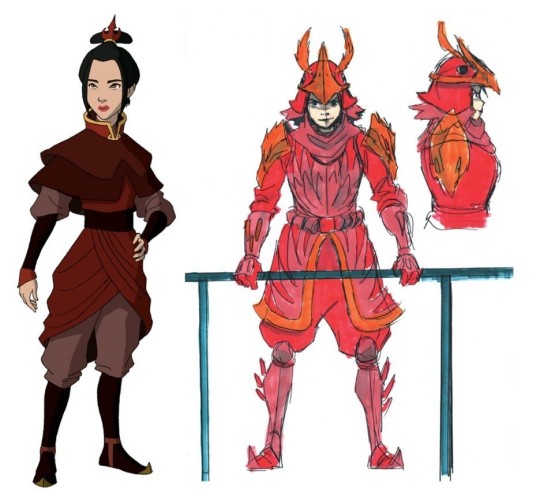

The more interesting question is what Azula's sword style would mainly be about?
By examining her firebending style in the series, Azula's style is more complex than the others confirmed by Sifu Kisu himself the Northern Shaolin and Chāquán (Islamic Long Fist) which are martial art styles counter one another (i.e in which you can say they're matches).
So by equivalize firebending to kenjutsu I think Niten Ichi Ryu school is the right answer. She would basically use a dual wielding of a long sword and a short one, the Nito Seiho; "two swords as one".

It's known for Samurais to carry two swords, both of them known as daishō (translated "big-little"). The shorter sword wakizashi is used in-doors, close-quarter combat and for ritual seppuku suicide or when the long sword katana is lost. [Photo of a man wielding both swords]
But Miyamoto Musashi, Japan's greatest Samurai, developed a style in which you can use both swords in battle. His mindset is similar to that of Azula; he was perusing invincibility and perfection, focuses on efficient movement and power, developing a subtle timing and distance to be removed from immediate danger while simultaneous creating an opening to strike the opponent.
He believes it's unworthy for the samurai to die with a sword still sheathed. Musashi claimed to have fought in more than 60 individual sword fights, many of which were to the death and he won all of them. He wrote a book on strategy in which he also examines the nature of combat and victory.
So, in such universe, I think Niten Ichi Ryu school would be a great influencer. There are 5 more styles but the above sword style is the most special.
79 notes
·
View notes
Text
Top Famous Japanese Samurai Names And History
The famous samurai is a famous character in Japanese culture. Samurai have been around for centuries and they are often the center of attention in many films, novels, and video games that are set during this time period. However, not everyone knows who some of these famous samurai were or what their stories entail. This article will list some famous samurai names and give you an overview of their history with the hope that it will help you get to know Japan's most famous warriors better!
There are many great samurai warriors in the Japanese history, such as Oda Nobunaga, Toyotomi Hideyoshi and Tokugawa Ieyasu. But there are other greatest to learn about Miyamoto Musashi or Tomoe Gozen - a fearsome female Samurai of Japan.
The samurai were a very well respected and powerful group of people. They followed the bushido code which is an honor-bound set of rules that prescribes how to live as a warrior, emphasizing practices such as martial arts mastery, integrity in life and death; courage; respect for one's opponents or superiors regardless of rank or social status (read more here). The Meiji Revolution abolished their power but they still had some influence on Japan way into present day because many became businessmen, professionals etc., while others helped shape Japanese culture!
If you are looking to learn more about samurai fighting styles, read this "What Type Of Martial Arts Did The Japanese Samurai Use?"
Here are a list of famous Japanese samurai names and history:
1) Miyamoto Musashi (1584 – 1645)
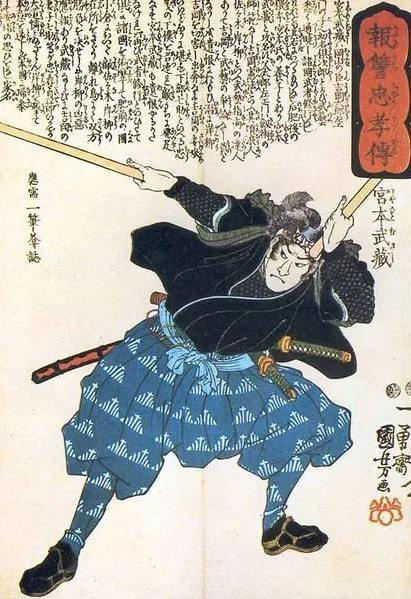
(Source, 1)
Born in 1584, Myamoto Mushashi was a famous and accomplished soldier, swordsman, and artist. When he was on the losing side of Battle Sekigahara in 1600 then he became ronin samurai which meant that his lord no longer recognized him as an official member of their army because they had lost this battle.
Miyamoto Musashi was a Japanese swordsman and philosopher who developed the two-sword technique known as nito ichi ryu. His reputation is so great that he has been referred to by other names, including kensai meaning sword saint or satsujin shoji which means killing machine in English.
He had many duels against rivals but his most famous fight occurred on an island with Saski Kojiro - ending quickly when Miyamato struck him over the head with a wooden sword after this duel, he retired from society despite teaching select students and helping suppress rebellions such as Shimabara of 1637.
Myamoto Mushashi was a great painter and author of the famous Book of Five Rings. He also wrote many other books on his martial art, philosophies, or sumi-e style paintings as well as bird paintings which are renowned in particular for Shrike Perched on Withered Branch (Kobokumeikakuzu) and Wild Geese Among Reeds (Rozanzu).
Myamoto Mushashi is most famously known for being an influential Japanese warrior who mastered multiple forms of combat from different cultures such as kenjutsu to jujitsu.
2) Toyotomi Hideyoshi (1537 – 1598)

(Source, 2)
Toyotomi Hideyoshi lived from 1536/37 to 1598 and served as chief Imperial minister. He helped finish to 16th-century unification of Japan, helping create the country we know today.
Born a peasant in Azumato Province (modern day Nagoya), Toyotomi Hideyoshi left home when he was still a boy and became page at one feudal lord's mansion where he met Oda Nobunaga who would become his mentor for life - or so it seemed until this great man rose through ranks becoming samurai under him before joining armies fighting other clans trying unify all of Japan with their own rule into what you see now on your map.
Hideyoshi, the man who would later build a castle in Osaka and become one of key figures in Japan’s unified government. He clashed with Tokugawa Ieyasu during Nobunaga's attempt to unify the country but their alliance remained strong. Hideyoshi was then appointed as an important minister by his lord Toyotomi Otomo so that he could continue pacifying regions without conflict from other lords like Tokugawa Ieyasu.
Toyotomi Hideyoshi was responsible for solidifying the caste restrictions that marked Tokugawa Japan. Farmers, merchants and monks were forbidden from taking up arms while warriors as well as artisans, farmers and tradesmen could only be found in their own areas of towns or villages due to strict segregation enforced by law.
3) Tokugawa Ieyasu (1543 – 1616)

(Source, 3)
The son of a local lord, Matsudaira Takechiyo was born in 1542. He came into his own during the era when Japan's civil war and feuding lords left it mired with violence and death.
After being sent to the Imagawa clan at four-years old, Ieyasu was raised with education in their court for 15 years. In 1567 he finally took over his family’s position and changed his name to Tokugawa after returning home from a life of exile.
He had a successful military career and ran his own town in the east of Japan. He was given governance over Edo where he established Tokyo, transforming it into what we know today as an international city with millions living there.
After the unfortunate death of his ally Toyotomi Hideyoshi, civil war broke out again. Ieyasu won the war and gained the title of shogun, becoming a military governor in Japan as well as its ruler with few limits on power. So began Tokugawa's rule over all but name for what would be three centuries to come until he passed away at age 80 in 1616 after having been ill for months beforehand due to illness or old age is not precisely known.
His mausoleum at Nikko has become one of most important shrines and was commissioned by Shogun himself from an artist who had taken up residence near Nagasaki during his time there trading with foreign merchants while simultaneously keeping firm control over Christianity-dominating Europe.
4) Oda Nobunaga (1534 – 1582)
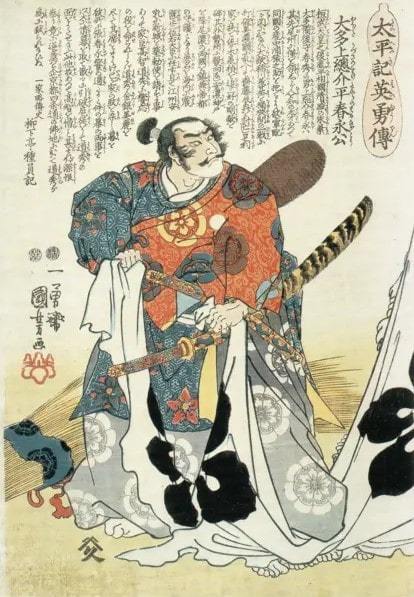
(Source, 4)
Oda Nobunaga's story is the source of many others, but it’s well worth knowing on its own. Born in 1534 and living through a deeply fractured Japan where warlords frequently clashed against one another often causing much death and destruction before he came to power, Oda nobunaga was viewed by some as both an oppressive tyrant and a national savior.
Nobunaga was an eccentric figure. When his father died and left him to take care of the family’s land, he took it with a strange sense of entitlement, associating freely with peasants below their station as well as shunning many traditions that were important under feudalism such how wearing funeral garb at one's own elaborate burial rites. Nobunaga would also break protocol in other areas like when Hirate Masahide committed suicide after being offended by Nobuna ga during said ceremony--the first time anyone had ever done so--- but this event seemed to shock into reality for the young boy who then went on to unite Japan through force instead of diplomacy or succession rights established within Yamato clan itself .
With the help of a few uncles, Nobunaga gained control over his land. He was not in power for long before he faced challenges from one brother and later another that only ended when both were killed by him. All of this happened while other feudal lords sought their own place among them.
The legacy of Nobunaga led to Tokugawa Ieyasu and his allies' unified, more stable Japan. This was because Nobunaga died before he could unite all of the country with a single government.
5) Kusunoki Masashige (1294 – 1336)
(Source, 5)
When Kusunoki Masashige was born in 1294, he had already been indoctrinated into the Akuto. This group of samurai banded together to form a new government that did not belong to the present regime and despised how under-rewarded they were for their actions fighting against Mongolia. A man with such passion would be destined for greatness - and so it is no surprise when one learns about his early life as an active member of this organization after being raised by parents who belonged themselves.
The Emperor, Go-daigo (96th emperor of Japan) was forced to flee when his plot for take down the government was revealed. He found refuge at Mt. Kasagi in south Kyoto and declared war on the Government who were against him because he wanted revenge after what they did to him years ago which is why he's been plotting this since then. Masashige pledged loyalty towards GOdaijo as one of first people who would help overthrow those cruel men from power so that no more innocent lives are lost just like how many others had died before them too due to their selfish behavior!
The soldiers of Kusunoki Masashige were not like other warriors. They didn't wear fine armor or swords, but they threw rocks and poured boiling water on those who tried to assault their castle in Kawachi! With the tide turning against them after news of the Emperor's arrest, he opted to burn down his castle and flee without ever being captured by government troops.
Masashige rallied his men and 1,000 locals in Osaka. The government responded in force by laying siege to the small army cutting off their supply lines but Masashige anticipated this and created a secret path for supplies that led to victory as starving forces instead starved with no new provisions from outside sources coming into play which also prompted Emperor Go-Daigo's return who then lead renewed efforts against the Shogun regime.
The samurai had been shortchanged and did not receive the land that they so desperately needed to get them out of poverty. Another rebellion rose in Kysusu, led by Ashikaga Takauji, whom Masashige was able to escape with after he saved his life during this time period.
Masashige encouraged the emperor to make peace, but he refused. He then tried to walk the Emperor into fleeing into exile, but that was refused as well. In the end Masashige led an army with a slim hope for victory against Ashikaga’s forces of 200,000; his own were 899 men strong and lost many on their journey in battle when they finally met near Osaka by 1336 AD where he succeeded suicide after being outnumbered so greatly..
Masahide's devotion and cunning have made him a very popular samurai hero especially within his native city-state (Osaka).
6) Hattori Hanzo (1542 – 1597)
Hattori Hanzo was a fearless warrior who performed many feats in service of the Tokugawa clan, including rescuing Tokugawa Ieyasu's daughter from a castle and laying siege to another. Born around 152 AD, he served until his death at 55- some sources state that this happened suddenly while hunting or died during battle with pirates on an island off the coast of Kyushu.
7) Sanada Yukimura (1567 – 1615)

Yukimura was born in 1567 and was known as A Hero who may appear once in a hundred years” and “Crimson Demon of War. His clan, the Sanada, caught up with wars between Oda Nobunaga forcing themselves to fight on different sides when Tokugawa took power after his death. Yukimura fought valiantly against them during Winter Siege at Osaka Castle causing many losses for enemy forces while he himself had smaller force size than that of enemies there.
I think you're tired of hearing about how Yukimura died, but in case it's not clear: he was fighting against Tokugawa forces and they managed to get him. The siege on Osaka castle went well for a while with him leading his troops during the battle until he finally conceded defeat after being completely outmatched by an enemy force that vastly outnumbered them at nearly 10-1 odds.
The defender of Osaka, exhausted and low on supplies but still as formidable as ever. Yukimura Sanada was a powerful general in the late Sengoku period who defended Osaka Castle against overwhelming odds before finally capitulating to Tokugawa Ieyasu's forces after months' worth of bitter fighting.
This heroic warrior is said to have made one last plea with his enemies: "I am Sanada Nobushige."
8) Uesugi Kenshin (1530 – 1578)
A long time ago, a young man named Nagao Torachiyo led an army in the fight against Takeda Shingen. He was born to be one of Japan's most powerful warriors and leaders when he changed his last name as refuge for Uesugi Norimasa who then adopted him as his son.
After his power had reached its peak, the mighty Uesugi sought to overthrow one of Japan's most powerful lords. He bravely faced all odds but unfortunately died before he could start a battle with Oda Nodabunaga.
9) Takeda Shingen (1521 – 1573)

(Source, 9)
Takeda Shingen, a 1521-born feudal lord of Shinano Province and one of the warlords who struggled for power over the valuable Kanto Plain in eastern central Honshu. He is best known for his series of battles with another famous warrior by Uesugi Kenshin that became legendary. The two fierce commanders clashed fairly indecisively but cemented Takeda's influence as he became one of the most powerful military leaders in region.
He was most feared by Oda Nodabunaga, and after defeating an army led by Ieyasu he began to make inroads into Tokugawa territory. A year following his victory over the armies of both men, Takeda died at age 39. To this day many people celebrate him as a genius who had skills that should be celebrated throughout all Japan due to the film Kagemusha (Shadow Warrior) directed by Kurosawa Akira being created about him.
10) Date Masamune (1567 – 1636)
Date Masamune was an incredible tactician who led the Date clan to power. He had a remarkable ability for warfare, earning him such nicknames as "One-Eyed Dragon of Ōshu". At one point he broke alliances and conquered land in his quest to hunt down a defected vassal from Ashina clan. After this campaign, many battles ensued against neighboring clans.
Tokugawa Ieyasu showed no fear when he was forced to choose a side during the Tokugawa-Toyotomi civil war, but once his overlord Hideyoshi died and left him with nothing. A man of great character, he eventually took up arms on behalf of Tokugawa's faction after finding that there was not enough food for both himself and the people in his domain. He then lead them all to an unexplored location which would grow into Sendai City thanks largely due to its proximity from fishing waters--an ideal place for those who are hungry or need work!
Masamune was known for his great sympathy for the Christian population growing in Japan, only reluctantly allowing their persecution in his domain when Ieyasu outlawed Christianity. It is because of Masamune's patronage that there are now a small community of Japanese descendants living in Spain as they fled to escape from religious prosecution on home soil.
Masamune was a powerful samurai who changed the political and cultural landscape of Japan forever. He has been represented in many media that chronicle both real and imagined versions of his life, but this is only scratching the surface to how influential he really was!
11) Honda Tadakatsu (1548- 1610)
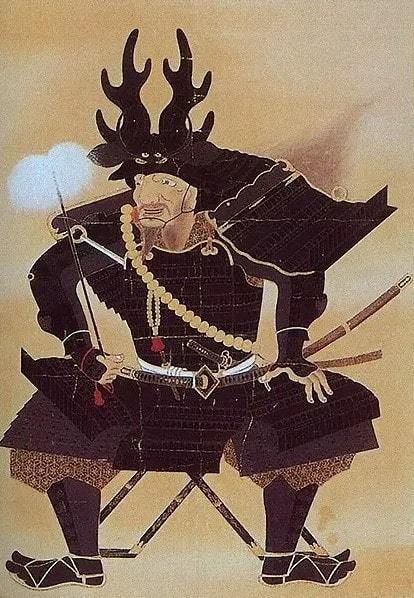
(Source, 11)
Honda Tadakatsu was a loyal servant of Tokugawa Ieyasu, and his contributions aided the success of countless battles. Perhaps being most noted for successfully leading evacuating troops from advancing Takeda forces before their decisive clash in 1584 during the Komaki Campaign, he would also go on to have great successes like breaking through an enemy's defensive line at Nagashino Castle with only 2 outposts left standing by nightfall after engaging them all day long.
His courage is said to have so impressed Toyotomi Hideyoshi, his foe in that battle, that he ordered a general ceasefire. Ieyasu was left with only a few troops but rode out and challenged the vast enemy host himself-and won! He continued to fight for Ieyasu through many battles and campaigns including Sekigahara where future shogun Tokugawa finally defeated him. It's hard not be inspired by this brave samurai who died protecting his lord at age 106 after serving him faithfully all those years ago.
12) Minamoto no Yoshitsune (1159 – 1189)
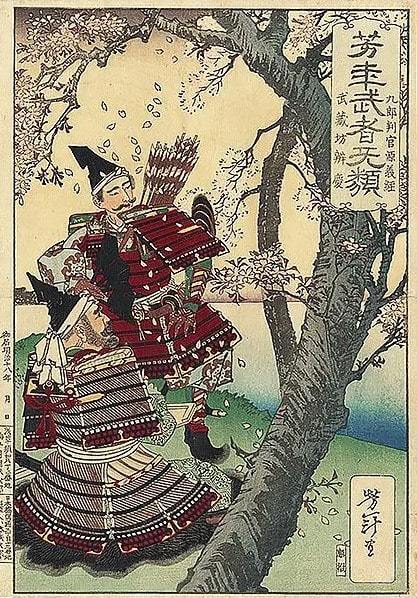
Yoshitsune was born in 1159, and is one of the most famous samurai's to have ever lived. He fought alongside his half-brother during Genpei War that led him on a path towards fame as he helped consolidate power with both humans and gods alike. Yoshitsune faced many challenges before embarking on this journey such as death at age 10 when overthrowing an attempted coup by court nobles leaded by Minamoto no Yoritomo who were seeking revenge for their father being killed from illness. It wasn't all bad though because after escaping execution himself thanks to monks taking care of him while residing within Kurama Temple.
Yoshitsune is a skilled samurai, the most respected and talented of his time. He took up arms against those who would take what belonged to him - that which was rightfully his by law. Against all odds he won every battle, liberating Japan from tyranny in the process as well as freeing it for himself following so many years spent without power or authority over anything at all."
Yoshitsune fell out of political favor when his brother Yoritomo schemed to end his growing power and forced him to flee Kyoto. He found refuge with Fujiwara no Yasuhira, son of the childhood protector he cherished so much. However, under pressure from Yoshitsune’s own brother-Yoritomo-he had a residence surrounded where Yoshitsune was staying at the time; defeated all retainers that were fighting for their lord in order to escape alive; and finally committed suicide."
A tragic hero as depicted by Japanese culture who has been deeply revered over many centuries: it is an open question whether or not Genghis Khan could have succeeded if without them knowing about this man's life story beforehand!"
13) Shimazu Yoshihisa (1533 – 1611)

One of the greatest leaders to ever live, Shimazu Yoshihisa was lord over Satsuma Province. Born in 1533 and died on March 5th 1611. He led his brothers uniting Kyushu which they claimed until Toyotomi Hideyoshi took it from them in 1600 but were defeated by him a few years later leading to their final years as Buddhist priests composing poetry that is cherished across Japan for its humility and skillful tactics!
from Bunka Japan - Japanese Samurai Bushido Culture https://ift.tt/3mdJQoB
from https://ift.tt/3sEeGb1
2 notes
·
View notes

